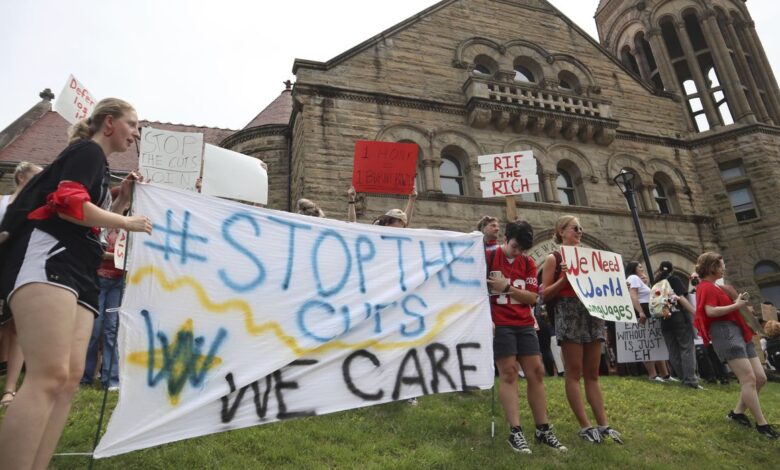
Universities across the country are facing challenges as they experience declining enrollments and increasing costs. To address these issues, many universities are making difficult decisions such as reducing services, raising tuition, and eliminating less popular majors.
These changes have been announced over the summer and at the end of the spring semester, and some students and faculty are now pushing back against these measures.
- In Morgantown, West Virginia, students at West Virginia University have protested against the proposed layoffs of up to 169 faculty members and the elimination of most foreign language programs.
- The University of Wisconsin system has approved a budget that predicts deficits for 10 out of 13 campuses due to a $32 million funding cut by the GOP-led Legislature. This has led to layoffs, retirement incentives, and furloughs in some schools within the system.
- Bemidji State University and Northwest Technical College in Minnesota have announced layoffs and retirement bonuses to address a 20% decrease in post-pandemic enrollment and a $9 million budget deficit. These schools have already been sharing resources to save money.
The decline in enrollments and the rise in costs are happening at a time when universities are facing a shrinking pool of students. According to the National Student Clearinghouse Research Center, four-year public colleges and universities have seen a 3.3% drop in enrollment from spring 2019 to spring 2023.
One of the reasons for this decline is that more high school graduates are hesitant to take on student loan debt, especially since the COVID-19 pandemic led to campus closures in March 2020. As a result, some students have decided to defer or skip college altogether.
In addition to low enrollments, state funding for public universities has also decreased. The National Education Association reported that 32 states spent less on public colleges and universities in 2020 compared to 2008. This has resulted in a decrease of nearly $1,500 per student on average.
The financial challenges faced by universities require them to make hard choices about faculty and staff salaries, campus facilities, and the services offered to students. These decisions aim to protect academic functions while cutting nonacademic costs.
While some universities have been criticized for their handling of budget cuts, it is important to acknowledge the larger issues at play. The financial strain on higher education institutions is a result of a combination of factors, including demographic changes, rising costs, and the impact of the pandemic.
As universities navigate these challenges, they must find innovative ways to address their financial situation while ensuring the quality of education for their students.
Unique Perspective: The financial struggles faced by universities are complex and require thoughtful solutions. While budget cuts and program eliminations may be necessary, it is crucial to prioritize the core mission of higher education and find ways to ensure access to education for all students, regardless of their socioeconomic backgrounds.




